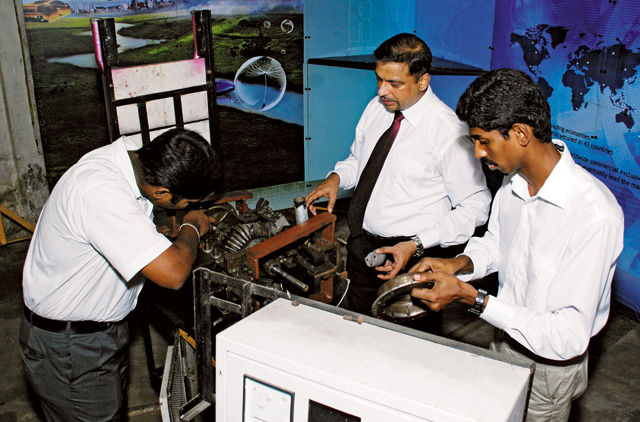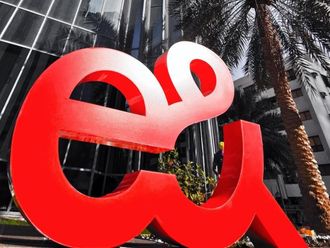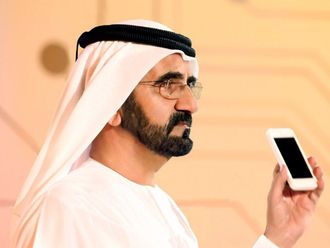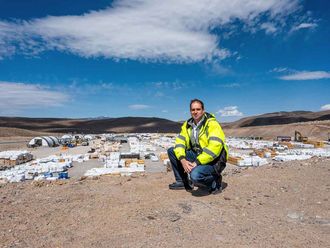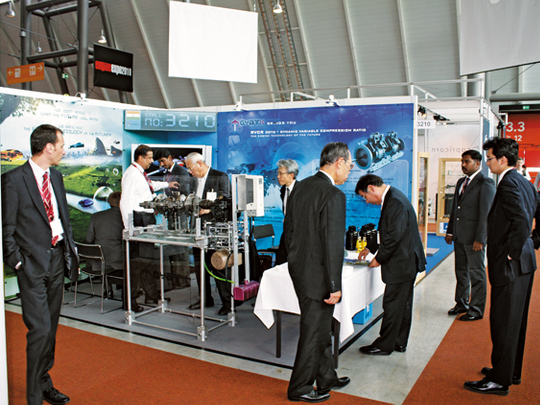
Thinking small can pay off big. Das Ajee Kamath is living proof of that dictum. As a student of mechanical engineering at the National Institute of Technology (NIT) in Durgapur, India, in 1986, Kamath's professor was teaching him how the internal combustion (IC) engine works when the light bulb moment occurred. "He was explaining its working through the vertical motion of pistons and that's when I asked him why not make it revolve instead of having the vertical motion. That would make the engine smaller, simpler and more efficient!"
His query generated so much derisive laughter, the resultant commotion buried its relevance. But the ridicule did not shake his conviction that his question resonated with validity. He went home and began to work on a wooden model based on his idea of revolving motion.
It was the beginning of an idea that today holds incalculable potential.
Sculpting the idea
Though Kamath has chiselled away at his wooden dream, his linear career progression was a routine he could not discard. His idea remained in the conceptual stage as he graduated, worked in the petrochemical industry for a year, till the pull of the sea made him take up a job as an engineer aboard a merchant navy ship. This turn in his career reignited the passion for his original idea.
"I used to study the workings of the huge turbine engines churning away in the ship as we sliced through the high seas, and I found my idea taking up more and more space in my mind," says Kamath. So whenever he had spare time, he worked out the sketches of what he was to call the rotary variable compression ratio (RVCR) technology in his head. As he grew more confident of the viability of his idea, he put the sketches down on paper, refining them and drawing up the ratios. In the process he learnt new things along the way. But we will come to that a little later in the story
What is RVCR?
To backtrack, what exactly is Kamath's invention? "In an IC engine, fuel is mixed with compressed air and ignited in a chamber," explains Kamath. "As the mixture explodes, the pressure in the chamber increases pushing a piston down within the chamber. As the piston is pushed down, the crank rotates and this motion is transmitted to rotate the wheel," he adds.
So far so good for those who possess rudimentary understanding of how the wheels of a car are set into motion. Now comes the tech jargon which Kamath struggles to simplify for motoring Luddites. He lays down the bare bones: when the air in the chamber is compressed, its temperature increases. This makes combustion possible. The compression ratio is fixed depending on the fuel: it is 7:1 for petrol (seven parts air to one part fuel), because petrol ignites faster compared to diesel (21:1). A fuel has a fixed compression ratio. It naturally follows that a fixed ratio engine, which is what all IC engines are, can burn only one type of fuel. There is no way of effectively changing the combustion ratio once the engine is designed.
Kamath sought to prove that he could design an engine with a chamber where he could change the compression ratio with the help of external devices; this would mean that he could use any type of fuel. This would also improve fuel efficiency.
He designed his engine in such a way that it could convert the force generated by the fuel directly to rotary motion, thus eliminating the vertical motion used in conventional engines.
The end result was an engine that did away with pistons, gudgeon pins, connecting rods - all used in conventional IC engines - thus reducing the weight and size of the engine. A conventional engine operates on two- or four-stroke cycles. Kamath's RVCR engine operates on single or two stroke.
The design was now formed in his mind. But he was still not ready to take the leap. But fate has strange ways of making things happen.
Crossing over
Call it an epiphany, but in 1999, about five years into designing his invention, Kamath who was onshore for some company business found himself walking past the patents office in Mumbai. So "I walked in on a whim to see if I could patent my engine," he says, a big grin springing up on his face. Nothing was to be gained immediately but he walked out with an armful of forms that had to be filled in to validate his invention. He went at it with his customary gusto. He formally applied for a patent that same year. He then went back to his ship, dreaming of when RVCR engines would take over the world.
It was 2003 when his conviction and hard work bore fruit and he was formally given a patent for his invention in India. Buoyed by his victory, he applied for a patent under the Patent Cooperation Treaty (PCT) (see sidebar on page 36).
"I wanted to see if anybody else had applied for one," he says. "The PCT is a combination of 115 countries. When you apply for a patent under the PCT, their office does an initial screening, and the patenting procedures include a written opinion, an international search report, and myriad other procedures.
"They came out with their international preliminary examination report in 2005. They then assigned my patent application to an examining office of my choice. I chose the European Patent Office because it is very stringent in its methods and is a union of 28 countries, including industrial giants such as Germany and France. I thought if they passed it I stood a good chance (of seeing my invention succeed)."
The report, when it came, swept away all doubts from Kamath's mind. It cited eight points on which his invention scored, including ‘novelty, inventiveness and industrial applicability'. "Till then I was not sure if anybody else had already invented such an engine," says Kamath. With the European office report, he finally got the necessary push to devote himself fully to his RVCR technology.
Going full steam
He quit his job in 2005 and floated his own R&D outfit, GYATK RVCR Apparatus Ltd in Kochi, Kerala. "I could have sold the idea, but I wanted to create a company that would nurture ideas from concept to prototype," says Kamath. "One of the most difficult engineering propositions is the design of an IC engine. It is one of our core requirements."
By 2007, they had designed and created a model RVCR engine that delivered on Kamath's promise.
The KSIDC (Kerala State Industrial Development Corporation) found his business proposal sound enough to invest Rs350,000 (Dh29,167) as seed money to develop the project. But it also took almost all his savings to procure international patents.
He was putting in 17 hours of work a day, which took a toll on his family but he is a fortunate man because they believed in his vision and supported him as he chased his dream.
"He was so confident that even though I was terrified (of the consequences) when he quit his job, I supported him wholeheartedly. He has that quality in him," says his wife Poornima, who now works with him as director of the company.
Starting from scratch
What makes Kamath's company unique is that it works on designs from scratch, and takes them right through to production. Perhaps the only companies that do similar projects are major multinational corporations or government bodies which can afford to spend millions of dollars on research and development.
"R&D requires huge resources, especially software that is not available to small players like us," he says. "The software we needed for our designs cost between Rs500,000 to Rs800,000, so we outsourced those aspects," says Kamath. "[On some occasions] we fell back on conventional methods - pen and pencil."
Garnering support
Once he got started, they was no stopping. He visited foundries and manufacturing units in Kochi where he used his persuasive skills to get them to manufacture his designs on a piece-meal basis.
One of his first supporters was KT George, an ex-ship engineer like himself, who runs an engineering consultancy in Kochi. It was easy to convince him as "I had studied the theory and felt that it could be done."
"What Kamath needs is special machining facilities, and if somebody is ready to invest in the project, his RVCR engine should be ready for trials in a year," says the soft-spoken George with undiluted confidence. Another supporter, Jacob Raju of Libra Engineering in Kochi, who has worked to give shape to Kamath's designs, says: "It is a marvellous product and I am just waiting to see it in motion. I am sure soon we will be able to say proudly that we have been associated with its production. It will certainly be a credit to India."
The breakthrough for the company came when an automotive major licensed their invention for commercial exploitation in the four-wheel and generator sector in India. However, there is a non-disclosure clause that prevents Kamath from revealing its identity till the engines are ready for production.
Stirring up a storm
Kamath however is irrepressible. He continued refining his RVCR concept, and then exhibited it at the Engine Expo 2010 at Stuttgart, Germany in May this year. It created quite a buzz at the expo with award-winning engineers from Volkswagen and BMW asking him to demonstrate his RVCR.
The event website also chose to feature Kamath's company along with a select few from the 3,000 participating companies.
Under the heading ‘VCR revolution', the organisers wrote: "Making the journey to Engine Expo 2010 from India is GYATK, whose breakthrough engine technology has created much interest at Hall 3 at the Messe Stuttgart. Patented in India, USA and other countries worldwide, GYATK's advanced, new technology centres on sequential operation of vanes inside a hollow toroidal chamber, thus eliminating reversal of inertia forces and the crank mechanism…"
"We saw that the Indian national flag was flying high along with the other flags at the Stuttgart venue!" says Kamath.
Fuel efficient
But all this is just the icing on the cake for Kamath. What he's really concerned about is the business aspect of RVCR - and its carbon footprint. "Alternative fuel technology - fuel cell, batteries, and so on, have not matured," he says.
"We are trying to get rid of fossil fuels, but just how viable is that at present? Let's face it, we need to run the engines, and we require fuel for that. The practical thing to do right now would be more fuel-efficient and lighter engines which can run on all kinds of fuel. That was our concern and that's what we offer."
The fossil fuel ecosystem cannot be wished away and neither can it go on for the carbon abatement concerns, says Kamath. The solution should be a smoother transition where fossil fuel is more efficiently used to create a smaller carbon footprint.
"RVCR with its multiple fuel flexibility and higher fuel efficiency is the transition and whoever controls it has a higher stake in the 21st century energy ecosystem," he says. "Technologies like RVCR, based on entirely new mechanism are of strategic importance to the oil-rich Middle East, as this technology covers for the lag with the West in terms of control on engineering expertise, and early investors get early lead in terms of adapting themselves to it."
Kamath is biding his time. "I am waiting for the day when we can be truly energy efficient. RVCR is only the beginning."
The patent cooperation treaty
PCT is an international patent law treaty, concluded in 1970. It provides a unified procedure for filing patent applications to protect inventions in each of its contracting states. A patent application filed under the PCT is called an international application, or PCT application.
A single filing of an international application is made with a Receiving Office (RO) in one language. It then results in a search performed by an International Searching Authority (ISA), accompanied by a written opinion regarding the patentability of the invention, which is the subject of the application. It is optionally followed by a preliminary examination, performed by an International Preliminary Examining Authority (IPEA). Finally, the relevant national or regional authorities administer matters related to the examination of application (if provided by national law) and issuance of patent. The PCT does not provide for the grant of an "international patent", as such multinational patent does not exist, and the grant of patent is a prerogative of each national or regional authority.
The contracting states, which are parties to the PCT, constitute the International Patent Cooperation Union.
The importance of RVCR to the Middle East
According to Kamath, the Middle East, by virtue of its crude oil resources, is at the base of the fossil fuel economy on which the human civilisation has thrived and flourished in the 20th century.
"This economy was based on continually incremental human dependency on fossil fuel since the industrial revolution," he says. "Today more or less every human aspect on earth is dictated by a direct or indirect connection to fossil fuel energy or down-stream products and the dependency can be called complete and total."
The Industrial Revolution, which was based on mechanised operations, started in Western Europe and did not happen in the rest of the world with the same effectiveness. Hence, the West benefited the most as it adapted to the industrial revolution faster. Later, the rest of the world including the Middle East began adopting rather than adapting to the Industrial Revolution as the force of increased productivity by mechanised operations far outweighed the traditional ways of business and trade.
The Middle East has a major control on the base raw material, namely crude oil, but not much on the downstream technologies, he says. The lack of control on technologies that consume oil and add value to it in multiples, translates into reduced say in the economy.
"To catch up one has to invest in new disruptive technologies. RVCR technology is the 21st century engineering mechanism alternative which provides a quantum leap in the fossil fuel technology. The intellectual property rights and know-how of RVCR can provide the region's economy with both control of the oil and applications that use oil, with greater control on the verticals of the fossil fuel economy. This will help Gulf economies to have a better say in carbon policies, sensible and responsible extended use of fossil fuel resources," he says.
A comparison between RVCR engine and a conventional engine
1. Fuel versatility
RVCR engine Runs on any fuel. Change over to fuel of choice during operation to suit load demand, fuel availability, and economy. LNG, petrol, diesel, bio diesel and so on.
Conventional engine Fuel specific engine (petrol or diesel). Replace engine for fuel change.
2. Compression ratio
RVCR engine Higher fuel efficiency by variable compression ratio, for any fuel at any load.
Conventional engine Constant compression ratio. Reduction of fuel consumption difficult.
3. Emission control
RVCR engine Enhanced emission control by dynamic peak pressure control by compression ratio manipulation.
Conventional engine Peak pressure control not possible.
4. Crank case and entablature
RVCR engine Downsized compact engine with no crank case and entablature. Conventional engine Size provisions for crank case and entablature inherent part.
5. Engine weight
RVCR engine No reciprocating piston, no gudgeon, no connecting rod and no crosshead. High power to weight ratio also suitable for aviation and marine applications.
Conventional engine Heavier engines.
6. Number of strokes
RVCR engine Single and dual stroke engines. Halves the strokes, further downsizing doubles the power per cycle.
Conventional engine Two- or four-stroke engines for completing gas cycle.
7. Vibration
RVCR engine Piston Vanes hinged. Cools easier, no clattering, vibrations eliminated. Conventional engine Piston floating on gudgeon causes vibration.
Kamath's promise
- A multi-fuel engine
- Quieter, cleaner engine with longer life
- Substantial improvement in fuel efficiency
- The new mechanism can be used for making cheaper pumps, metering devices or compressors
Understanding RVCR
The RVCR engine is like a syringe in the shape of a circular ring. The piston rotates inside a hollow ring. There are two vanes (fan-like structures) inside the chamber and compression is achieved by keeping one constant and moving the other against it. There are various advantages of this new mechanism compared to the existing "crank mechanism" which is very cumbersome.
Conventional engines can run on only one type of fuel, but an engine made using the RVCR mechanism can run on different fuels. For example, a petrol car cannot run on diesel. But a RVCR engine will run on any fuel.
In this new invented engine you can use either LPG or LNG or CNG or even heavy fuel. You can even change over from one fuel to another while the engine is running.
The new invented mechanism results in a smaller, lighter and compact engine that is cheaper and more flexible.
RVCR is a base mechanism and not only an engine technology. It can power zero emission machines like wind motors and tidal energy motors for electric generation.


